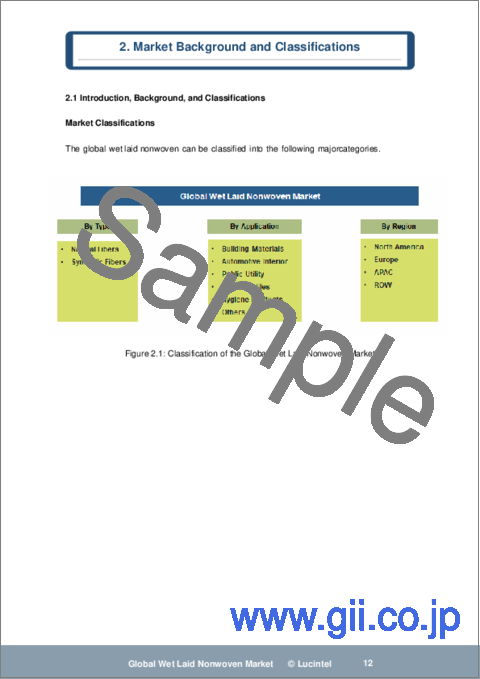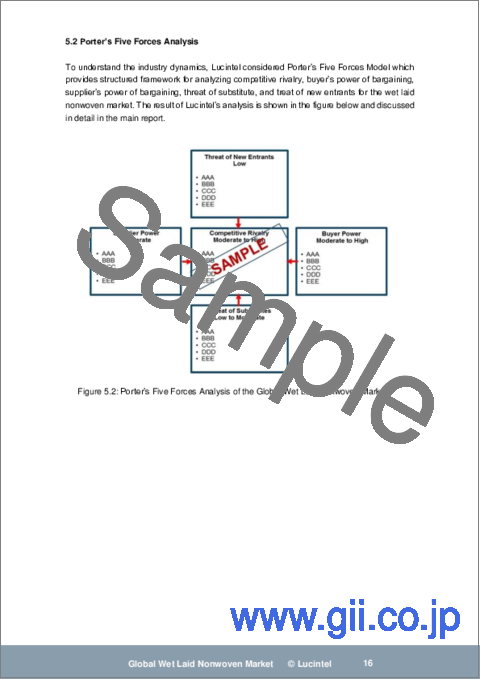|
|
市場調査レポート
商品コード
1356888
湿式不織布市場レポート:2030年までの動向、予測、競合分析Wet Laid Nonwoven Market Report: Trends, Forecast and Competitive Analysis to 2030 |
||||||
カスタマイズ可能
適宜更新あり
|
|||||||
| 湿式不織布市場レポート:2030年までの動向、予測、競合分析 |
|
出版日: 2023年09月01日
発行: Lucintel
ページ情報: 英文 150 Pages
納期: 3営業日
|
- 全表示
- 概要
- 目次
ウェットレイド不織布の動向と予測
世界のウェットレイド不織布市場は、2024年から2030年までのCAGRが5.8%で、2030年までに推定34億米ドルに達すると予想されています。この市場の主な促進要因は、衛生・医療分野からの需要増加、ろ過・分離目的でのウェットレイド不織布の利用増加、ウェットレイド不織布の製造工程における革新的強化です。世界のウェットレイド不織布市場の将来は、建材、自動車内装、公共事業、家庭用繊維、衛生製品市場でのビジネスチャンスで有望視されています。
ウェットレイド不織布市場の洞察
Lucintelは、不織布に使用される基本繊維の80%以上が合成繊維であり、入手のしやすさ、手頃な価格、堅牢な耐久性、耐摩耗性、洗浄のしやすさなど、さまざまな利点があることから、予測期間中も合成繊維が高成長を維持すると予測しています。
この市場の中では、衛生用品が予測期間中最大のセグメントであり続けると思われます。その優れた吸収特性、柔らかさ、滑らかな肌触り、強度、快適性、フィット感、伸縮性、費用対効果により、不織布素材は衛生用品の生産において従来のテキスタイルの実行可能な代替品として役立ちます。
アジア太平洋は、急速な産業成長と都市拡張のペースに加え、同地域内の建設セクターにおける不織布材料の需要の増加により、予測期間中最大の地域であり続けると思われます。
本レポートでは、以下の11の主要な質問に回答しています:
- Q.1.市場セグメントのうち、最も有望かつ高成長な機会は何か?
- Q.2.どのセグメントがより速いペースで成長するのか、またその理由は?
- Q.3.今後成長が加速すると思われる地域とその理由は?
- Q.4.市場力学に影響を与える主な要因は何か?市場における主な課題とビジネスリスクは?
- Q.5.この市場におけるビジネスリスクと競合の脅威は?
- Q.6.この市場における新たな動向とその理由は?
- Q.7.市場における顧客の需要の変化にはどのようなものがありますか?
- Q.8.この市場における新たな開発と、その開発をリードしている企業は?
- Q.9.この市場における主要企業は?主要企業は事業成長のためにどのような戦略的取り組みを進めているのか?
- Q.10.この市場における競合製品にはどのようなものがあり、材料や製品の代替による市場シェア低下の脅威はどの程度ありますか?
- Q.11.過去5年間にどのようなM&Aが行われ、業界にどのような影響を与えましたか?
目次
第1章 エグゼクティブサマリー
第2章 世界の湿式不織布市場:市場力学
- イントロダクション、背景、分類
- サプライチェーン
- 業界の促進要因と課題
第3章 2018年から2030年までの市場動向と予測分析
- マクロ経済動向(2018~2023年)と予測(2024~2030年)
- 世界の湿式不織布市場動向(2018-2023)と予測(2024-2030)
- タイプ別の世界の湿式不織布市場
- 天然繊維
- 合成繊維
- 用途別の世界の湿式不織布市場
- 建材
- 自動車内装
- 公益企業
- ホームテキスタイル
- 衛生用品
- その他
第4章 2018年から2030年までの地域別の市場動向と予測分析
- 地域別の世界の湿式不織布市場
- 北米の湿式不織布市場
- 欧州の湿式不織布市場
- アジア太平洋湿式不織布市場
- その他地域湿式不織布市場
第5章 競合の分析
- 製品ポートフォリオ分析
- 運用上の統合
- ポーターのファイブフォース分析
第6章 成長機会と戦略的分析
- 成長機会分析
- タイプ別の世界の湿式不織布市場の成長機会
- 用途別の世界の湿式不織布市場の成長機会
- 地域別の世界の湿式不織布市場の成長機会
- 世界の湿式不織布市場の新たな動向
- 戦略的分析
- 新製品の開発
- 世界の湿式不織布市場の能力拡大
- 世界の湿式不織布市場における合併、買収、合弁事業
- 認証とライセンシング
第7章 有力企業の企業プロファイル
- Hangzhou Nbond Nonwoven
- Xinhua Group
- Freudenberg
- Dalian Ruiguang Nonwoven
- Wuhu Rynd Nonwovens
- Hollingsworth & Vose
- ANDRITZ
- Lydall
- Berry Global
- Ahlstrom-Munksio
Wet Laid Nonwoven Trends and Forecast
The future of the global wet laid nonwoven market looks promising with opportunities in the building material, automotive interior, public utility, home textile, and hygiene product markets. The global wet laid nonwoven market is expected to reach an estimated $3.4 billion by 2030 with a CAGR of 5.8% from 2024 to 2030. The major drivers for this market are rising demand from the hygiene and medical sectors, increasing utilization of wet-laid nonwovens for filtration and separation purposes, and innovative enhancements in the manufacturing process of wet-laid nonwovens.
A more than 150-page report is developed to help in your business decisions.
Wet Laid Nonwoven by Segment
The study includes a forecast for the global wet laid nonwoven by type, application, and region.
Wet Laid Nonwoven Market by Type [Shipment Analysis by Value from 2018 to 2030]:
- Natural Fibers
- Synthetic Fibers
Wet Laid Nonwoven Market by Application [Shipment Analysis by Value from 2018 to 2030]:
- Building Materials
- Automotive Interior
- Public Utility
- Home Textiles
- Hygiene Products
- Others
Wet Laid Nonwoven Market by Region [Shipment Analysis by Value from 2018 to 2030]:
- North America
- Europe
- Asia Pacific
- The Rest of the World
List of Wet Laid Nonwoven Companies
Companies in the market compete on the basis of product quality offered. Major players in this market focus on expanding their manufacturing facilities, R&D investments, infrastructural development, and leverage integration opportunities across the value chain. With these strategies wet laid nonwoven companies cater increasing demand, ensure competitive effectiveness, develop innovative products & technologies, reduce production costs, and expand their customer base. Some of the wet laid nonwoven companies profiled in this report include-
- Hangzhou Nbond Nonwoven
- Xinhua Group
- Freudenberg
- Dalian Ruiguang Nonwoven
- Wuhu Rynd Nonwovens
- Hollingsworth & Vose
- Andritz
- Lydall
- Berry Global
- Ahlstrom-Munksio
Wet Laid Nonwoven Market Insights
Lucintel forecasts that synthetic fiber will remain the higher growing segment over the forecast period because over 80% of the fundamental fibers used in nonwoven textiles are synthetic, as well as it offers a range of advantages, including accessibility, affordability, robust durability, resistance to wear, and ease of cleaning.
Within this market, hygiene products will remain the largest segment over the forecast period due to their exceptional absorption properties, softness, smooth texture, strength, comfort, fit, stretchability, and cost-effectiveness, nonwoven materials serve as a viable substitute for conventional textiles in the production of hygiene products.
APAC will remain the largest region over the forecast period due to swift pace of industrial growth and urban expansion, along with an increasing requirement for nonwoven materials in the construction sector within the region.
Features of the Global Wet Laid Nonwoven Market
Market Size Estimates: Wet laid nonwoven market size estimation in terms of value ($B).
Trend and Forecast Analysis: Market trends (2018 to 2023) and forecast (2024 to 2030) by various segments and regions.
Segmentation Analysis: Wet laid nonwoven market size by type, application, and region. in terms of value ($B).
Regional Analysis: Wet laid nonwoven market breakdown by North America, Europe, Asia Pacific, and Rest of the World.
Growth Opportunities: Analysis of growth opportunities in different types, applications, and region.s for the wet laid nonwoven market.
Strategic Analysis: This includes M&A, new product development, and competitive landscape of the wet laid nonwoven market.
Analysis of competitive intensity of the industry based on Porter's Five Forces model.
FAQ
Q.1. What is the wet laid nonwoven market size?
Answer: The global wet laid nonwoven market is expected to reach an estimated $3.4 billion by 2030.
Q.2. What is the growth forecast for wet laid nonwoven market?
Answer: The global wet laid nonwoven market is expected to grow with a CAGR of 5.8% from 2024 to 2030.
Q.3. What are the major drivers influencing the growth of the wet laid nonwoven market?
Answer: The major drivers for this market are rising demand from the hygiene and medical sectors, increasing utilization of wet-laid nonwovens for filtration and separation purposes, and innovative enhancements in the manufacturing process of wet-laid nonwovens .
Q.4. What are the major segments for wet laid nonwoven market?
Answer: The future of the wet laid nonwoven market looks promising with opportunities in the building material, automotive interior, public utility, home textile, and hygiene product markets.
Q.5. Who are the key wet laid nonwoven market companies?
Answer: Some of the key wet laid nonwoven companies are as follows:
- Hangzhou Nbond Nonwoven
- Xinhua Group
- Freudenberg
- Dalian Ruiguang Nonwoven
- Wuhu Rynd Nonwovens
- Hollingsworth & Vose
- ANDRITZ
- Lydall
- Berry Global
- Ahlstrom-Munksio
Q.6. Which wet laid nonwoven market segment will be the largest in future?
Answer: Lucintel forecasts that synthetic fiber will remain the higher growing segment over the forecast period due to over 80% of the fundamental fibers used in nonwoven textiles are synthetic, as well as it offers a range of advantages, including accessibility, affordability, robust durability, resistance to wear, and ease of cleaning.
Q.7. In wet laid nonwoven market, which region is expected to be the largest in next 5 years?
Answer: APAC will remain the largest region over the forecast period due to swift pace of industrial growth and urban expansion, along with an increasing requirement for nonwoven materials in the construction sector within the region.
Q.8. Do we receive customization in this report?
Answer: Yes, Lucintel provides 10% customization without any additional cost.
This report answers following 11 key questions:
- Q.1. What are some of the most promising, high-growth opportunities for the wet laid nonwoven market by type (natural fibers and synthetic fibers), application (building materials, automotive interior, public utility, home textiles, hygiene products, and others), and region. (North America, Europe, Asia Pacific, and the Rest of the World)?
- Q.2. Which segments will grow at a faster pace and why?
- Q.3. Which region will grow at a faster pace and why?
- Q.4. What are the key factors affecting market dynamics? What are the key challenges and business risks in this market?
- Q.5. What are the business risks and competitive threats in this market?
- Q.6. What are the emerging trends in this market and the reasons behind them?
- Q.7. What are some of the changing demands of customers in the market?
- Q.8. What are the new developments in the market? Which companies are leading these developments?
- Q.9. Who are the major players in this market? What strategic initiatives are key players pursuing for business growth?
- Q.10. What are some of the competing products in this market and how big of a threat do they pose for loss of market share by material or product substitution?
- Q.11. What M&A activity has occurred in the last 5 years and what has its impact been on the industry?
Table of Contents
1. Executive Summary
2. Global Wet Laid Nonwoven Market : Market Dynamics
- 2.1: Introduction, Background, and Classifications
- 2.2: Supply Chain
- 2.3: Industry Drivers and Challenges
3. Market Trends and Forecast Analysis from 2018 to 2030
- 3.1. Macroeconomic Trends (2018-2023) and Forecast (2024-2030)
- 3.2. Global Wet Laid Nonwoven Market Trends (2018-2023) and Forecast (2024-2030)
- 3.3: Global Wet Laid Nonwoven Market by Type
- 3.3.1: Natural Fibers
- 3.3.2: Synthetic Fibers
- 3.4: Global Wet Laid Nonwoven Market by Application
- 3.4.1: Building Materials
- 3.4.2: Automotive Interior
- 3.4.3: Public Utility
- 3.4.4: Home Textiles
- 3.4.5: Hygiene Products
- 3.4.6: Others
4. Market Trends and Forecast Analysis by Region from 2018 to 2030
- 4.1: Global Wet Laid Nonwoven Market by Region
- 4.2: North American Wet Laid Nonwoven Market
- 4.2.2: North American Wet Laid Nonwoven Market by Application: Building Materials, Automotive Interior, Public Utility, Home Textiles, Hygiene Products, and Others
- 4.3: European Wet Laid Nonwoven Market
- 4.3.1: European Wet Laid Nonwoven Market by Type: Natural Fibers and Synthetic Fibers
- 4.3.2: European Wet Laid Nonwoven Market by Application: Building Materials, Automotive Interior, Public Utility, Home Textiles, Hygiene Products, and Others
- 4.4: APAC Wet Laid Nonwoven Market
- 4.4.1: APAC Wet Laid Nonwoven Market by Type: Natural Fibers and Synthetic Fibers
- 4.4.2: APAC Wet Laid Nonwoven Market by Application: Building Materials, Automotive Interior, Public Utility, Home Textiles, Hygiene Products, and Others
- 4.5: ROW Wet Laid Nonwoven Market
- 4.5.1: ROW Wet Laid Nonwoven Market by Type: Natural Fibers and Synthetic Fibers
- 4.5.2: ROW Wet Laid Nonwoven Market by Application: Building Materials, Automotive Interior, Public Utility, Home Textiles, Hygiene Products, and Others
5. Competitor Analysis
- 5.1: Product Portfolio Analysis
- 5.2: Operational Integration
- 5.3: Porter's Five Forces Analysis
6. Growth Opportunities and Strategic Analysis
- 6.1: Growth Opportunity Analysis
- 6.1.1: Growth Opportunities for the Global Wet Laid Nonwoven Market by Type
- 6.1.2: Growth Opportunities for the Global Wet Laid Nonwoven Market by Application
- 6.1.3: Growth Opportunities for the Global Wet Laid Nonwoven Market by Region
- 6.2: Emerging Trends in the Global Wet Laid Nonwoven Market
- 6.3: Strategic Analysis
- 6.3.1: New Product Development
- 6.3.2: Capacity Expansion of the Global Wet Laid Nonwoven Market
- 6.3.3: Mergers, Acquisitions, and Joint Ventures in the Global Wet Laid Nonwoven Market
- 6.3.4: Certification and Licensing
7. Company Profiles of Leading Players
- 7.1: Hangzhou Nbond Nonwoven
- 7.2: Xinhua Group
- 7.3: Freudenberg
- 7.4: Dalian Ruiguang Nonwoven
- 7.5: Wuhu Rynd Nonwovens
- 7.6: Hollingsworth & Vose
- 7.7: ANDRITZ
- 7.8: Lydall
- 7.9: Berry Global
- 7.10: Ahlstrom-Munksio





